Giza, also spelled Guiza or Gizeh, is a name that conjures up images of the grandest pyramids in Egypt. Its necropolis, particularly the breathtaking and unparalleled constructions, stand as the epitome of the ancient Egyptian civilization. For travelers thirsting for knowledge and yearning to experience the most captivating places on earth, a visit to the pyramids of Giza is an absolute must.
The pyramids of Giza hold a prominent spot on the list of the world’s most incredible tourist attractions. They have maintained their allure since ancient times when they marked a significant stopover for the Greek historian Herodotus during his mid-5th century BC travels – making him one of the earliest tourists. They have captivated every generation that followed from different historical eras, especially since the emergence of Egyptology in the 19th century.
To this day, they draw thousands of visitors daily, keen on exploring the Giza pyramid complex. Additionally, significant discoveries related to the pyramids are still being unearthed. As the only remaining wonder of the ancient world, the pyramids of Giza hold a unique position in history. Their historical significance and proximity to other essential sites in ancient Egypt, such as Dahshur, saw them designated as a UNESCO World Heritage Site under the title ‘Memphis and its Necropolis. Areas of the Pyramids from Giza to Dahshur.’
Fortunately, significant strides have been made in understanding the pyramids of Egypt and their maintenance, leading to an improved tourist experience when visiting the pyramids of Giza. An excellent illustration of this is the construction of the Grand Egyptian Museum of Giza, a vast complex that we will discuss in detail shortly.
In addition, we will also cover other attractions in Giza, which have diverse themes and are more closely associated with tourism in Cairo due to their proximity to the heart of the Egyptian capital, such as the zoo or the Pharaonic Park. If you want to gain an understanding of all these attractions before arriving at this remarkable destination and embarking on a trip to the pyramids of Giza, take note. And if you need help planning your trip and enjoying it comfortably and securely, don’t hesitate to contact Egipto Exclusivo. We will handle all the details for you!
It is worth noting that despite being often considered as a suburb of Cairo, Giza is actually a separate city, located in a different governorate. In Egypt, governorates are administrative regions similar to autonomous communities in Spain or states in Mexico. Giza, in fact, is the capital of the Giza Governorate, with a population ranging from 4.5 million to 8.8 million depending on various sources and geographical boundaries.
However, Giza and Cairo are part of the same metropolitan area, with the Nile River being the only physical boundary that separates the two cities. They are well connected by bridges, roads, metro, buses, and even boat rides, making them essentially one contiguous urban area.
Interestingly, many of Cairo’s iconic places and tourist attractions are actually located within the territory of Giza. For example, the Cairo University, the Orman Botanical Garden, and the Zoo are all in Giza. Therefore, we have grouped these and other points of interest on this page, under the section ‘Other Attractions not related to Ancient Egypt’.
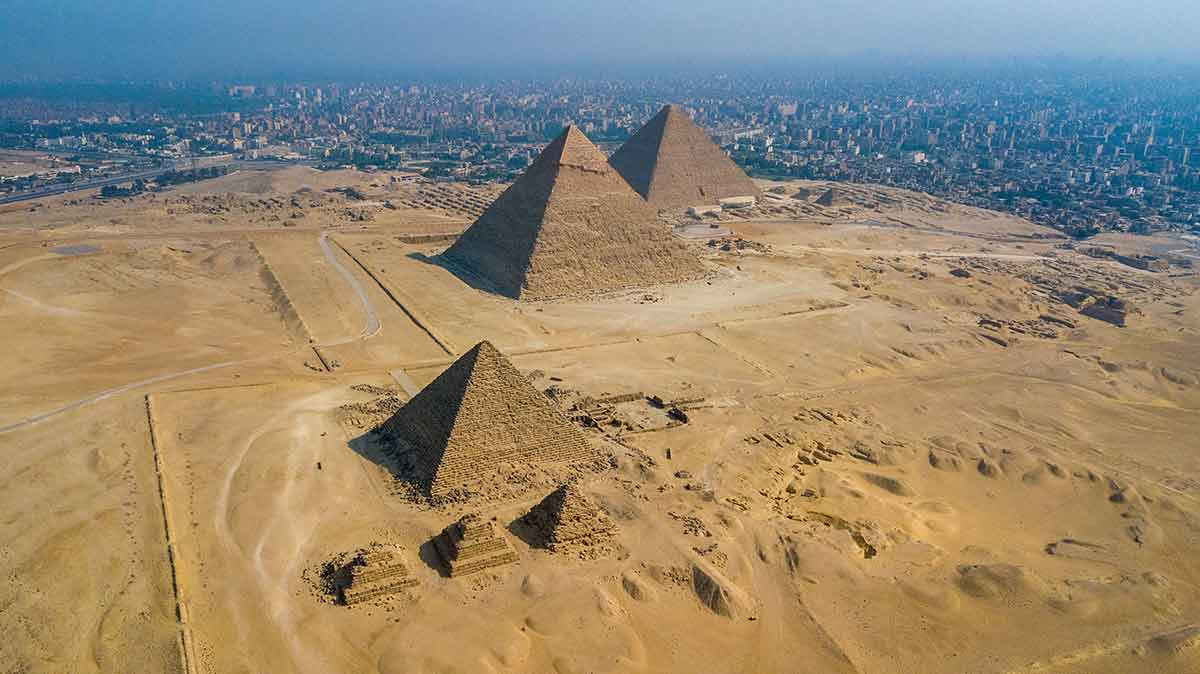
The story of Giza inevitably leads us back to ancient Egypt, when it first became known to the world. Although it wasn’t yet a city, it was a necropolis located on what we now call the Giza Plateau. This was the chosen burial ground for the Fourth Dynasty of the Old Kingdom, who ruled Egypt between approximately 2600 and 2500 BCE.
The most important pharaohs of that era belonged to this dynasty, and they were known for their centralized power, territorial dominance, and ability to mobilize vast economic and human resources. Back then, the capital was Memphis, and Giza was just another empty plateau. But for some reason, Pharaoh Khufu (also known as Cheops) decided that this spot, which rises magnificently above the Nile Valley to an altitude of about 915 meters above sea level, was the perfect location for his grand funerary project: the largest and most perfectly constructed pyramid in all of Egypt.
And he succeeded, as we can still see today, although the pyramid has lost some of its height and splendor due to looting and the reuse of its stone blocks for other structures. Khufu was followed by other pharaohs, notably Khafre (also called Khafra) and Menkaure (or Mycerinus), who each made their own contributions. Together, they created what we now know as the pyramids of Giza, as well as the Great Sphinx of Giza, which was probably constructed during Khafre’s reign. But there are also other structures, such as the pyramids of the queens and the mastabas of the priests, which we’ll examine in more detail later.
After the Fifth Dynasty (approximately 2500-2350 BCE), the Giza necropolis continued to be respected as a funerary space and there are constructions datable to this period, but it ceased to be the preferred burial area for the pharaohs, who preferred other necropolises in places like Saqqara or Abusir. In addition, for long periods it fell into disuse, without even minimum maintenance that would at least remove layers of sand deposited for centuries.
In the New Kingdom (approximately 1550-1069 BCE), however, sensitivity for ancestors was once again recovered and important additions or modifications were made in the vicinity of the pyramids of Giza, by pharaohs of the Eighteenth Dynasty (approximately 1550-1295 BCE). For example, Thutmose I, Amenhotep II, and even Tutankhamun, despite the fact that all these monarchs already had the habit of being buried in the Valley of the Kings in Thebes (now Luxor).
Recent discoveries have also revealed the use that was made of Giza in the Late Period or Lower Epoch (approximately 664-332 BCE), when it was no longer customary to build pyramids in Egypt. Especially during the Twenty-Sixth Dynasty (664-525 BCE), the last one considered as Egyptian and reigning before the Persian conquest. For example, polychrome sarcophagi probably belonging to priests of that period, which makes clear the religious and funerary symbolism of Giza for the local clergy, who wished to remain emotionally connected to the ancestors who preceded them 2,000 years ago.
With the decline of ancient Egypt, Giza’s role as a necropolis came to an end. Neither the Copts, Romans, nor Byzantines used it for burial purposes. However, the pyramids’ fame continued to grow. Antipater of Sidon, a Greek writer from the 2nd century BC, mentioned them as one of the most significant monuments of his time, which is considered a precursor to the list of the Seven Wonders of the Ancient World.
Later, in the mid-7th century AD, after the conquest of Egypt by the Arab general Amr ibn al-As, a settlement was founded in Giza as a place to live, distinct from the function that the Giza pyramids had as a necropolis. The Islamic settlers likely gave it the current name, al-Jizzah.
However, Giza remained more of a settlement of country houses, while neighboring Cairo monopolized the significant investments of the different rulers of the country and became the capital. The Giza plateau served as a source of materials for various Cairo constructions, as did other pyramids in Egypt. Some caliphs made modifications to the Giza pyramids themselves, such as Al-Ma’mun in 820, who created an opening to enter directly into the pyramid of Khufu.
During the 19th century, the rise of Egyptology and the expansion of railway transportation systems led to an increase in tourism to the Giza pyramids. A tramway was even built to connect Cairo with the necropolis, running through the fields that once covered the area. This route became the foundation for the current Al-Haram highway.
In the second half of the 20th century, the rapid growth of Giza was fueled by the high population density of the Egyptian capital, leading many residents to seek new housing options on the other side of the Nile River. This resulted in an unprecedented period of development, with numerous apartment blocks springing up to accommodate the expanding local population. Unfortunately, this development also led to the near-total disappearance of the once-green areas that dotted the landscape, though a few isolated exceptions such as the Mahmoud Khail Museum still remain and will be discussed later.
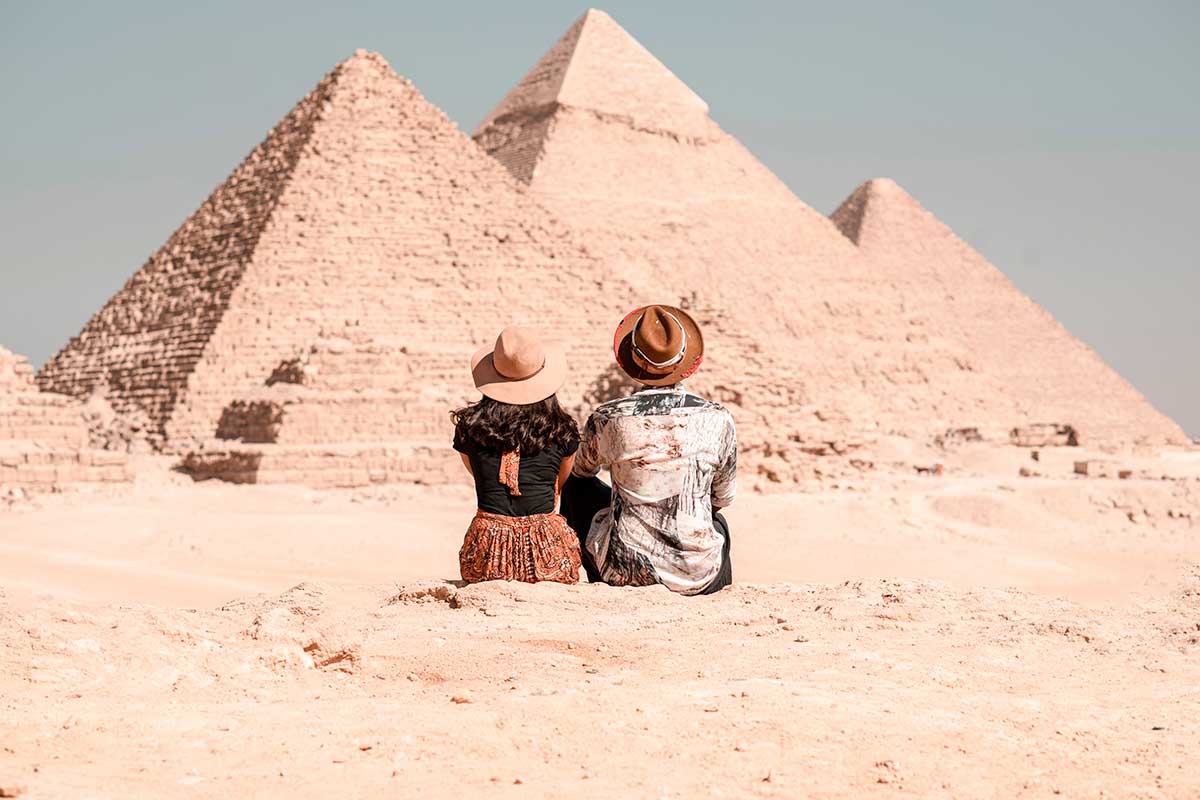
No cabe duda de que las pirámides de Giza ponen a esta ciudad en el mapa turístico internacional. Por ello, la necrópolis de la que forman parte es su principal lugar de interés. A continuación te mostramos, uno por uno, los elementos más destacados de este macro complejo funerario, también llamado Meseta de Giza.
There were numerous pyramids in Ancient Egypt. And although many of them have been lost, many are still counted today: more than a hundred in different states of conservation. However, the most famous are undoubtedly the pyramids of Giza, which are also among the best preserved.
And not by chance: technically, the pyramids of Giza are considered ‘perfect’. As we explained on the page dedicated to Architecture in Ancient Egypt, the pyramids of Egypt were the evolution of funerary mastabas. The truncated pyramid shape of these mastabas gave way to the stepped pyramids, like that of Djoser in Saqqara. Then the bent pyramids were erected, more ‘accomplished’, with exterior faces sloping down towards the summit. And finally, the perfect pyramids, with millimeter-precise blocks fitted together to create four sides of a completely smooth surface up to the apex.
As we were saying, nowadays we can hardly imagine this fact, since the exterior limestone cladding was dismantled to use the blocks in other later constructions of Cairo. Only a little of this exterior cladding is preserved on the pyramid of Khafre, at the summit, and in some very specific points of those of Cheops and Menkaure.
Let’s remember that the pyramids of Giza, like all the pyramids of Egypt, are funerary constructions. Their practical purpose was to contain the tomb of the pharaoh, in the case of the most monumental, and of the queens or other important characters, in the case of the smaller ones. And symbolically, they served to contain the essence of such a character, preserving it for eternity and facilitating their ascension to the sky to transfigure in the form of a star and, with that, achieve true immortality.
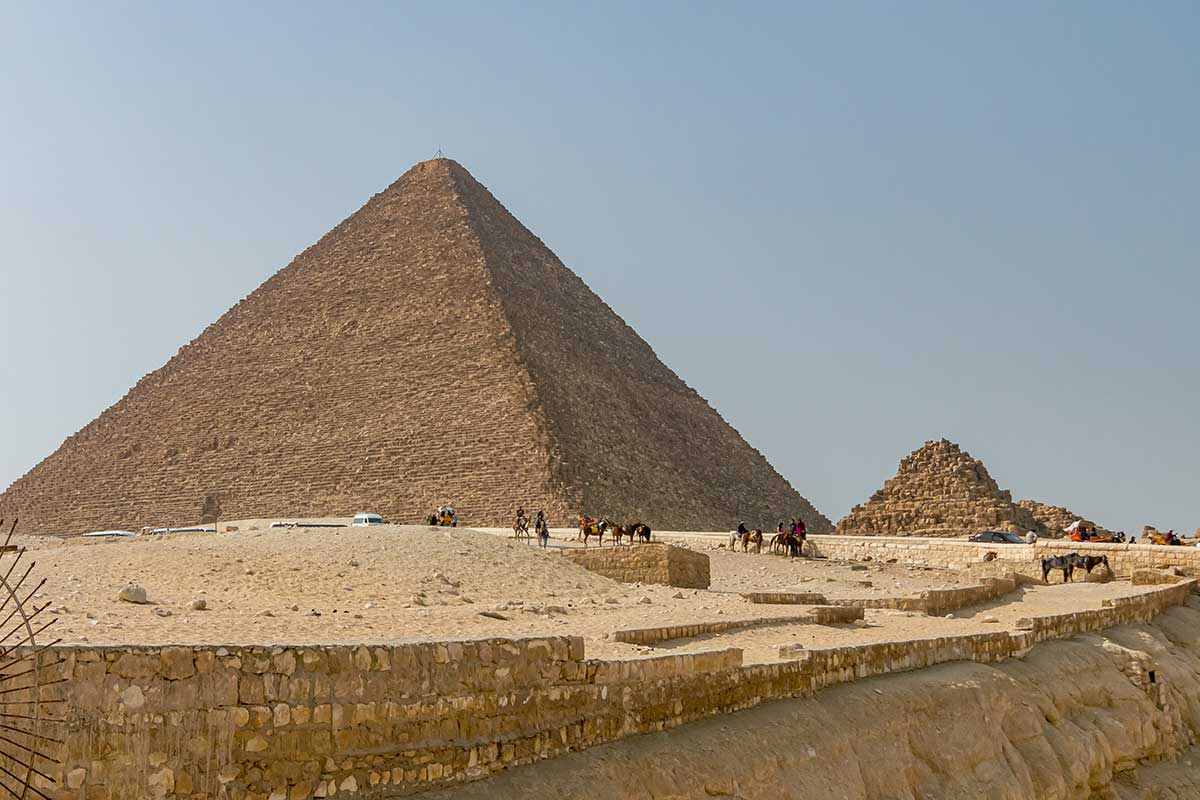
The Khufu Pyramid was the first pyramid built in Giza, and it played a crucial role in establishing the necropolis that we see today. The reason why Khufu, who reigned approximately from 2589 to 2566 BC, chose this location for his burial instead of Dashur, where his father Senefru had built the Red Pyramid, is not clear. One possibility is that the natural elevation of the plateau gave it greater prominence from the Nile valley, or the technical conditions for construction, such as the availability of limestone from Tura, were better on this site.
The pyramid’s impressive statistics speak for themselves. At present, it stands at a height of around 138 meters, although it once stood over 146 meters, thanks to its limestone cladding. Its square base measures about 230 meters on each side, making it the largest and tallest pyramid in Egypt at the time of its construction. While it is debated whether the ruined pyramid of Dyedefra in Abu Roash surpassed its height, it is generally agreed that Khufu Pyramid remained the largest pyramid in Egypt.
The pyramid of Khufu, also known as Cheops or Jufu, is an engineering marvel and a testament to the architectural prowess of Ancient Egypt. It required an estimated 2.3 million stone blocks, with around 27,000 blocks used for the outer casing alone. The mastermind behind this grandiose project is believed to be Hemiunu, who was also the vizier of pharaoh Khufu. Some of the key features of the pyramid and its surroundings include:
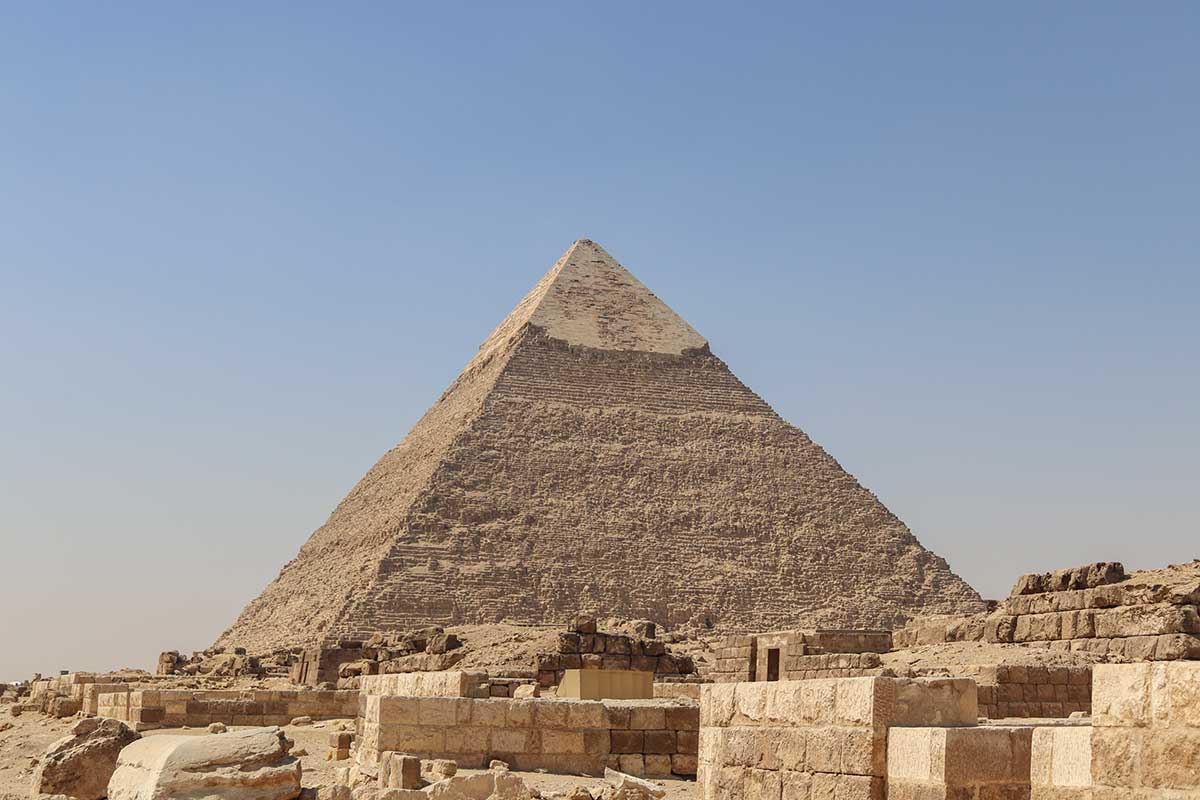
Khafre, one of Khufu’s sons, also built his own funerary complex in Giza. His pyramid, located slightly southwest of his father’s, is the second largest of the Giza pyramids, standing at around 136 meters. Although its original height was about 143 meters, Khafre decided not to surpass his father’s pyramid in size.
The pyramid’s dimensions are approximately 213 meters on each side, with a steeper angle of inclination than Khufu’s pyramid. Despite this, it appears to be taller than Khufu’s pyramid due to an optical illusion and its location on slightly higher ground. Its peak still retains a small layer of casing stones.
Khafre’s funerary complex includes more than just his pyramid. It also comprises:
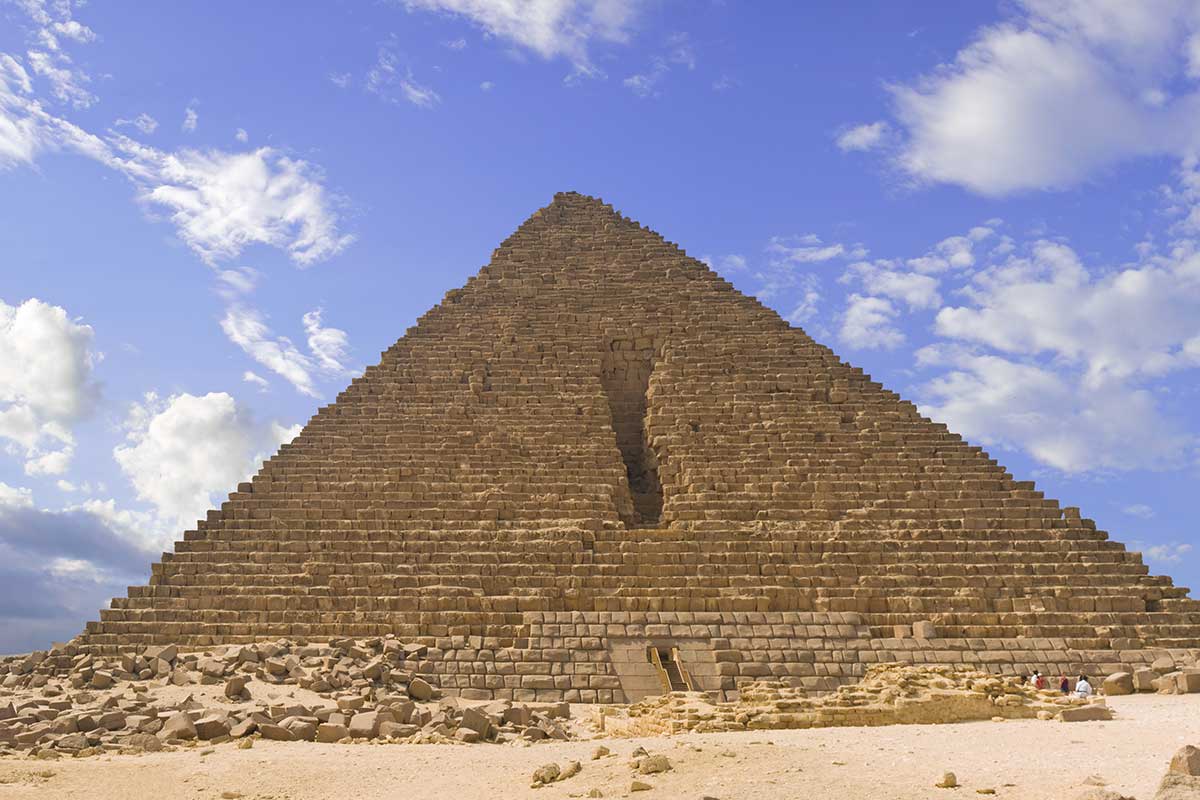
The Pyramid of Menkaure was built by Menkaure, the son of Khafre and grandson of Khufu, between 2514-2486 BC. It is the smallest of the three pyramids at Giza, leading some Egyptologists to suggest that it is a reflection of the waning power of the pharaohs. However, it is still a significant structure, with sides measuring 102 and 104 meters at the base and an original height of 65 meters, now standing at around 61 meters due to the loss of its casing.
The pyramid was originally covered in pink granite from Aswan and white limestone from Tura, with some limestone blocks still visible at the base. In the 12th century, Othman ibn Yousef, son of Saladin, attempted to dismantle the pyramid, resulting in a large cut on the north face.
Like the other pyramids at Giza, the Pyramid of Menkaure is surrounded by related elements, including:
Aside from the three main pyramids in Giza, there are other smaller pyramids that serve the same function, as well as other constructions that are related to each of the three funerary complexes. These include:
Furthermore, the Giza necropolis is also dotted with various cemeteries that consist of different mastabas or tombs. Some of the noteworthy ones are:
Apart from these funerary constructions, there are remnants of other related spaces, such as workers’ warehouses and quarries.
The Grand Egyptian Museum is an important museum that deserves special attention. Although it is not located exactly in the Giza necropolis, but about 2 km away from the Giza pyramids, it is closely related to them. The museum is a massive and modern construction that covers an area of about 50 hectares, standing 40 meters high and 800 meters long. Its main purpose is to exhibit a significant portion of the treasures found in the pyramids of Egypt and other archaeological sites across the country.
Undoubtedly, the Grand Egyptian Museum is the Egyptian government’s biggest initiative to promote quality cultural tourism in the country, recognizing that the Egyptian Museum in Cairo had long been too small. As a result, some pieces of the collection of the Grand Egyptian Museum come from the Egyptian Museum in Cairo, while the majority of the collection comes from warehouses and museums in other cities across the country, such as Alexandria, Luxor, Assiut, Sohag, Beni Suef, and El Fayum.
The construction of the Grand Egyptian Museum in Giza, also known as GEM, began in 2008 and its international significance was evident from the start, with more than 1,500 proposals from over 80 countries submitted to the competition. The Irish firm Heneghan Peng won the competition and developed a stunning project that includes:
The Grand Egyptian Museum of Giza boasts an impressive collection catalog that contains anywhere between 50,000 to 100,000 artifacts, depending on various estimates. Among these, several must-see items include:
While Giza is best known for its magnificent pyramids, there are also other options for visitors looking for something different in this city. In fact, there are alternative attractions beyond Egyptology, which dominates the pyramids of Giza and the bustling capital of the country. These attractions provide a “third way,” particularly enjoyable for families, with fun and leisurely places for children to enjoy. Let’s take a closer look at them.
No tourist destination is complete without an amusement park, and in Giza, the star theme can only be Ancient Egypt. That is the setting of this small park located on the eastern bank of the Nile, opposite the island of Jacob. It is primarily aimed at younger children, who will be mesmerized by the park’s decorations and, above all, by the actors and monitors’ costumes and characterizations.
The park features activities and performances with pharaohs, queens, priests, and court members as protagonists. It also offers other options for older youth, such as escape rooms with mummies. Children’s workshops, parks, and even a fun cruise on the Nile are also available in the park’s catalog.
For those seeking an adrenaline rush, Dream Park in Giza is the perfect amusement park for both locals and tourists. Situated on the opposite side of the Giza pyramids, approximately 25 km from the left bank of the Nile, this park offers classic roller coasters, water slides, and spinning structures for a more intense experience. With an area of approximately 150 hectares, Dream Park has a capacity for over 3,000 visitors per day and boasts around fifty attractions, including trains, carousels, and other options for younger children. In addition, the park features dining areas and commercial stores to cater to visitors’ needs.
For families looking for a more natural and relaxed atmosphere, the Giza Zoological Gardens is a must-visit destination in the Cairo area. Located near the banks of the Nile, close to Rhoda Island, it is not only the largest zoo in Egypt but also a green oasis spanning over 30 hectares, offering a respite from the oppressive heat of the city.
Founded in the late 19th century by Jadive Ismail, the Giza Zoological Gardens is a project that put Cairo on par with other major cities in the West. The zoo boasts of an iron bridge designed by Gustave Eiffel, adding to its historical charm.
With over 175 species and approximately 6,000 specimens, the Giza Zoological Gardens is home to a diverse range of wildlife, including indigenous breeds like the Egyptian cobra, also known as Cleopatra’s asp due to its association with the legendary queen. The reptile section is especially noteworthy, with the Egyptian cobra being a highly symbolic animal for the pharaohs as it represented the goddess Uadyet.
Migratory birds, such as flamingos and ibis, are also a prominent feature of the zoo. Visitors can also spot large felines like lions, giraffes, rhinoceroses, and other species strongly associated with Africa.
For a tranquil escape in the bustling city of Giza, adjacent to the Giza Zoo, is the Orman Garden, a renowned botanical garden in the Cairo metropolitan area. Created almost at the same time as the Giza Zoo, it was part of the garden of Khedive Ismail’s palace in the late 19th century. With a slightly smaller area than its neighbor, the Orman Garden is divided into different sections, such as the rock garden, rose garden, and cactus garden, each showcasing unique flora.
One of the most striking features of the Orman Garden is the lotus pond, a natural space deeply connected to Ancient Egyptian culture. It represents purity, birth, and the invocation of the god Ra, as its petals open when exposed to the sun’s rays. Visitors can stroll along the paths and bridges that surround the pond, observing the beauty of the lotus flowers and enjoying a peaceful break from the city’s hustle and bustle.
Cairo University is the largest and most prominent institution of higher education following Western-style education. It was established as a modern counterpart to the Islamic teaching center of Al-Azhar University, which is widely regarded as the oldest of its kind in the world and continues to maintain international prestige today.
Situated in Giza, rather than Cairo, it was founded at the turn of the 20th century and boasts a vast campus adjacent to the botanical garden and zoo, with a distinctive central administrative building featuring a colossal dome. The university comprises around twenty faculties, including Medicine, Law, and Archaeology.
One of the most iconic features of Cairo University, appreciated by both residents and visitors alike, is the Renaissance of Egypt sculpture. Created by the renowned artist Mahmoud Mukhtar, it is considered the most significant work of 20th century Egyptian art. The sculpture is strategically located near the Cairo University Bridge, with the university dome looming in the background. It offers a captivating view between the botanical garden and the zoo.
It is important not to mistake Cairo University with New Giza University, a private institution established more recently in 2016. New Giza University is situated in the exclusive New Giza area, quite distinct from the older and larger Cairo University.
Preserved as one of the few remaining 19th-century mansions in Giza, the Mohamed Mahmoud Khalil Museum provides a glimpse of what the area looked like before the demographic surge of the late 20th century. Named after an Egyptian minister from the 1930s who was not only a politician but also a great collector, especially of Western modern art, the museum’s collection is considered one of the best of its kind in the metropolitan area of Cairo and all of Egypt.
The impressive catalog of artists represented in the museum includes Auguste Rodin for sculpture and painters such as Corot, Pisarro, Millet, Renoir, Sisley, Monet, Gauguin, Degas, Toulouse-Lautrec, and Van Gogh. The latter’s series of paintings of lilies is a particular highlight and a major draw for visitors.
A tour to the Pyramids of Giza is a must-do excursion for any traveler visiting Cairo. It’s often the main reason for their trip, and if that’s the case for you, you can find information on how to travel here from the Cairo section. Most likely, you’ll need to land at the airport in the Egyptian capital, but soon the new Sphinx International Airport will be inaugurated, serving Giza and the entire West of Cairo.
If you plan to spend several days exploring the Pyramids of Giza, their necropolis, and other attractions, it’s useful to know about accommodation, transportation, and other practical information.
When it comes to accommodation, you have two great options: stay in the vicinity of the Pyramids of Giza or opt for a hotel in Cairo. The Egyptian capital offers more variety, but the hotels located next to the necropolis are of high quality. International hotel chains have a presence in the area between the Pyramids of Giza and the Grand Egyptian Museum, making it an interesting option for travelers who prioritize visiting both places.
New Giza, located further to the west, is an upscale residential neighborhood that boasts some of the most state-of-the-art amenities in the Cairo metropolitan area. Along with the previously mentioned New Giza University, there is also a golf course, international schools, luxury hotels, and other premium accommodation options. For this reason, it is an excellent choice for travelers seeking the utmost in quality standards.
Regarding transportation, getting around Giza may not be very comfortable if you exclusively rely on public transportation. Metro Line 2 runs through part of the city, with several stops such as El Bohoos, Cairo University, Giza, Sakkiat Mekki, and El Monib. However, this can be considered only a solution for short trips to the west bank of the Nile, where the zoo, botanical garden, university, and Pharaonic Park are located.
New Giza is a residential area located to the west of Giza, which offers some of the most modern and exclusive facilities in the metropolitan area of Cairo. It is home to the University of New Giza, a golf course, international schools, luxury hotels, and other high-end accommodation options. Therefore, it is an ideal choice for travelers who prioritize top-quality standards.
Public transportation is not the most comfortable option to get around Giza. The Metro Line 2 runs through part of the city, with stops such as El Bohoos, Cairo University, Giza, Sakkiat Mekki, and El Monib, but it is only suitable for short trips to the west bank of the Nile, where the zoo, botanical garden, university, and Pharaonic Park are located.
The Pyramids of Giza are very far away and not accessible by metro, and the bus from downtown Cairo (lines 355 and 357) is not the most recommended option.
In this regard, the most appropriate means of transportation is the white taxi, as they have modern and comfortable vehicles. The standard fare is 2.50 LE for the initial flag and 1.25 LE per kilometer. Pink taxis driven by women for female travelers have also emerged as a gesture of trust and security.
At the foot of the Pyramids of Giza, near the access control checkpoint and the Mena House Hotel, there is a tourist information office where you can learn about visits to the necropolis, the Grand Egyptian Museum, and other attractions in the city. However, information on the Pyramids of Giza and nearby attractions can also be found at offices in downtown Cairo.
If you wish, Egipto Exclusivo can provide you with the best transportation, accommodation, and information services. Private taxis and minivans with drivers are available for transportation, and a variety of hotel or villa options are available for accommodation. The best guides are also available to ensure you enjoy every visit to the fullest. Contact Egipto Exclusivo to make the most of your trip to the most famous pyramids in Egypt.


Fill out the form below to receive a free, no-obligation, tailor-made quote from an agency specialized in Egypt.
Travel agency and DMC specializing in private and tailor-made trips to Egypt.
Mandala Tours, S.L, NIF: B51037471
License: C.I.AN-187782-3